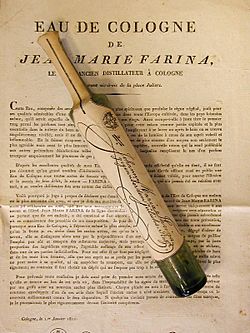Eau de Cologne facts for kids
Cologne or Eau de Cologne is a toiletry, a perfume in a style of that originated from Cologne, Germany. Nowadays, it's used as a term for scented formulations with a concentration of about 2-5% essential oils. Cologne may be used by men or women.
Contents
Composition
In a base of dilute ethanol (70-90%), Eau de Cologne contains a mixture of citrus oils including oils of lemon, orange, tangerine, bergamot, lime, grapefruit and neroli. It can also contain oils of lavender, rosemary, thyme, petitgrain (orange leaf), and jasmine.
History
Eau de Cologne is a spirit-citrus perfume launched in Cologne in 1709 by Giovanni Maria Farina (1685-1766), an Italian perfumer from Santa Maria Maggiore Valle Vigezzo, Italy. In 1708, Farina wrote to his brother Jean Baptiste: "I have found a fragrance that reminds me of an Italian spring morning, of mountain daffodils and orange blossoms after the rain" (Eckstein p.8). He named his fragrance Eau de Cologne, in honour of his new hometown.
The Original Eau de Cologne composed by Farina was used only as a perfume and delivered to "nearly all royal houses in Europe" (Farina Fragrance Museum information leaflet). His ability to produce a constantly homogenous fragrance consisting of dozens of monoessences was seen as a sensation at the time. When free trade was established in Cologne by the French in 1797, the success of Eau de Cologne prompted countless other businessmen to sell their own fragrances under the name of Eau de Cologne and even Farina.
Giovanni Maria Farina's formula has been produced in Cologne since 1709 by Farina opposite the Jülichplatz and to this day remains a secret. His shop at Obenmarspforten opened in 1709 and is today the world's oldest fragrance factory. Other Colognes, such as the famous Cologne 4711, named after its location at "Glockengasse No. 4711", have the name in common but smell different. In 1806, Jean Marie Joseph Farina, a grand-grand-nephew of Giovanni Maria Farina (1685-1766), opened a perfumery business at Paris that developed into Roger & Gallet, that owns the rights to Eau de Cologne extra vielle in contrast to the Original Eau de Cologne from Cologne.
Eau de Cologne, or just "cologne", has now become a generic term.
Images for kids
-
Cordon Rouge, François Coty (1909)
See also
 In Spanish: Agua de Colonia para niños
In Spanish: Agua de Colonia para niños







